Bates Motel: Season One Blu-ray Movie
HomeBates Motel: Season One Blu-ray Movie 
Blu-ray + UV Digital CopyUniversal Studios | 2013 | 434 min | Rated TV-14 | Sep 17, 2013
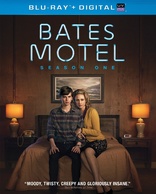
Movie rating
8.3 | / 10 |
Blu-ray rating
| Users | 5.0 | |
| Reviewer | 4.0 | |
| Overall | 4.4 |
Overview
Bates Motel: Season One (2013)
A teenage Norman Bates and his mother Norma move to an old house overlooking the adjoining motel which they are renovating. The house and motel both come with secrets of their own as does the new town which the Bates family now calls home. A modern re-imagining and prequel to the movie Psycho (1960).
Starring: Freddie Highmore, Vera Farmiga, Max Thieriot, Olivia Cooke, Nestor CarbonellDirector: Tucker Gates, Ed Bianchi
| Horror | Uncertain |
| Psychological thriller | Uncertain |
| Mystery | Uncertain |
| Coming of age | Uncertain |
| Thriller | Uncertain |
| Drama | Uncertain |
Specifications
Video
Video codec: VC-1
Video resolution: 1080p
Aspect ratio: 1.78:1
Original aspect ratio: 1.78:1
Audio
English: DTS-HD Master Audio 5.1
Subtitles
English SDH, Portuguese, Danish, Finnish, Norwegian, Swedish
Discs
50GB Blu-ray Disc
Two-disc set (2 BDs)
UV digital copy
Mobile features
Packaging
Slipcover in original pressing
Playback
Region free
Review
Rating summary
| Movie | 4.5 | |
| Video | 4.5 | |
| Audio | 4.5 | |
| Extras | 2.5 | |
| Overall | 4.0 |
Bates Motel: Season One Blu-ray Movie Review
Norma(n)
Reviewed by Michael Reuben December 22, 2013The A&E TV series Bates Motel is usually described as a "prequel" to Psycho, and the term is accurate to the extent that the show depicts a teenage version of Norman Bates, the adult character originally conceived by novelist Robert Bloch, whose book was the basis for Alfred Hitchcock's 1960 classic. But Bates Motel is only a "prequel" to Psycho in the same sense that the BBC's hit series Sherlock is a "remake" of any previous movie or TV version of the Sherlock Holmes stories. Sherlock's success is largely due to its reinvention of an iconic character for the modern age. In the same vein, Bates Motel showrunners Carlton Cruse and Kerry Ehrin (veterans of Lost and Friday Night Lights, respectively) have reconceived Norman Bates as a 21st Century teen inhabiting an entirely different world than the one surrounding the character that Anthony Perkins played for Hitchcock. This Norman even lives in a different town, although the motel and the famous gothic house are identical to those in Hitchcock's film. Like Sherlock's Baker Street address, some things are timeless. Perhaps the most important element in Bates Motel's reinvention is that Norman's famous mother, Norma, now has a voice of her own. In Psycho, she became what a commentator called one of the most famous cinematic corpses in history, her voice supplied entirely by her son. In Bates Motel, she is a richly complex character with a mysterious past, operatic emotions and explosive mood swings. Cruse and Ehrin wrote the role thinking of actress Vera Farmiga, with little expectation that she'd be interested, but the part was too good to turn down. Farmiga was nominated for an Emmy for a performance that is mesmerizing, pitiful and scary, all at once. One of the less-noted aspects of Psycho is how much it diverges from Hitchcock's own formula for suspense, which is to give the audience plenty of information so that they can thoroughly dread what's coming. In Psycho, by contrast, Hitchcock mostly withholds information, while simultaneously dissembling about where the real danger lies—or even who the movie is about—so that the viewer is constantly shocked by unexpected developments. The last ten minutes of the film require lengthy exposition by a psychiatrist who explains how everything fits together. In Bates Motel, by contrast, we already know that Norman and his mother are deeply disturbed people and that Norman is destined to kill her some day, conceal the crime and suffer intolerable guilt that fractures his psyche. But our understanding of mental illness has advanced significantly in the fifty years since Psycho. The creators of Bates Motel want to explore in greater depth and detail the forces that turn a young man into a monster and a mother's love into a torment so great that killing her becomes the only solution. Updating the story to the present reveals possibilities that Hitchcock and his screenwriter, Joseph Stefano, never imagined. It turns out that the world against which Norma Bates constantly warns her son really is filled with dangers, some of them from genuine criminals and some from sexually aggressive women who thoughtlessly meddle with a sensitive boy's fragile sense of masculinity. Do they deserve to die for that? No, but they're playing with fire.
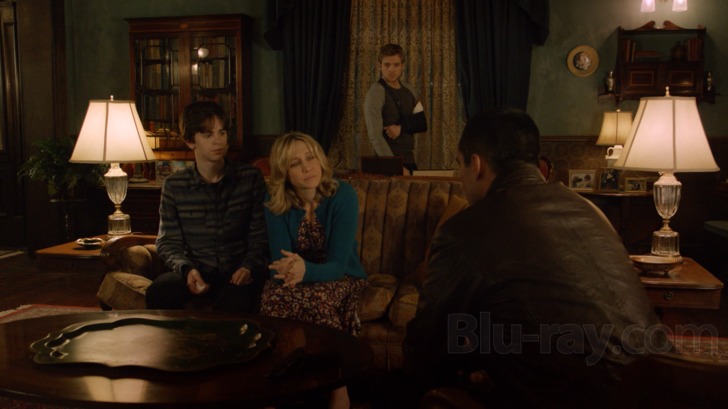
By reinventing the story of Norman and his mother, the creators of Bates Motel made room for a rich supporting cast that provided plenty of surprises as the season proceeded. Just describing who they are might be considered a "spoiler" by some; so the truly sensitive should skip this section. The young Norman is played by Freddie Highmore, best known for Finding Neverland and Charlie and the Chocolate Factory. Twenty years old when he filmed Season One, he has the gangly appearance and the reserved air to be credible as an earlier version of the character played by Anthony Perkins without resorting to outright mimicry. In the first episode, Norman awakens from troubled sleep to find his father dead on the floor of the family garage, the victim of an apparent accident involving collapsed shelving. His mother, Norma (Farmiga), is taking a shower. When Norman summons her, she seems sad but undisturbed. Obviously there is more to this story. Further detail will be revealed later in the season, but when the source is Norma Bates or her son, can you ever fully trust what you hear? Six months later, mother and son have relocated to the coastal Oregon town of White Pine Bay (as compared to the Hitchcock film's Fairvale, California) to start a new life. Norma has used the life insurance proceeds to buy a Mercedes and purchase a rundown motel from a bank foreclosure, which she plans to renovate and operate with Norman. The motel and the forbidding house overlooking it will be familiar to anyone who has ever seen Psycho (or taken the Universal Studios backlot tour in California). On his first morning in his new school, Norman is given a ride by a bevy of teenage girls giggling over the new boy and led by the local queen bee, Bradley Martin (Nicola Peltz), on whom Norman develops an instant crush. She finds him intriguing, and events later in the season will conspire to draw them close for a brief period, but it is not a viable relationship. A more likely companion for Norman is Emma Decody (Olivia Cooke), a student who shares his outsider's perspective, because she suffers from cystic fibrosis and travels with an oxygen tank as a permanent companion. Emma, too, is fascinated by Norman, although for a long time, he only has eyes for Bradley. Indeed, one of the interesting discoveries in Bates Motel is that Norman, without realizing or understanding it, is a great favorite with women, possibly because he seems to be so gentle, non-macho and unthreatening—a stark contrast to the usual high school boy. (If they only knew.) Even his English teacher, Miss Watson (Keegan Connor Tracy), responds to this quality in Norman. The high school in White Pine Bay is shiny and modern, and all the students are beautifully attired. This isn't a case of Hollywood prettification. The entire town's prosperous appearance belies the depressed state of the economy, and with good reason. White Pine Bay survives on an entire underground economy that only begins to reveal itself as Season One unfolds. Turf wars, gunfire and arson are routine features of life in this town. Norma's real estate broker somehow failed to mention any of this, just as he omitted reference to the proposed highway bypass that will eventually isolate the motel from any significant traffic (another carryover from Hitchcock's film). "Nice town you picked, Norma", says Norman's half-brother, Dylan (Max Thieriot), when he arrives to join them. Wait a second—Norman Bates has a brother?! In the reimagined world of Bates Motel, Norma Bates was married twice, and each marriage produced a son. Norma's overprotective love of Norman is explained, in part, by her utter failure with Dylan, who refuses to call her "mom" and has never forgiven her for leaving him and his father. The relationship between Dylan and Norman is complex, ranging from intense, and sometimes violent, sibling rivalry to a strong impulse on Dylan's part to play the big brother and rescue Norman from a mother that Dylan doesn't trust. Having had to live independently for much of his life, Dylan has acquired the kind of skills that make him useful to the criminal elements in White Pine Bay. He quickly finds employment, the kind his mother can't know about. An immediate danger confronting the Bates family is the motel's former owner, Keith Summers (W. Earl Brown), a drunken reprobate who was none too pleased about losing the property to the bank. He appears on Norma's front lawn shortly after her family arrives making all manner of threats. She and Norman soon discover that Summers was doing more on the property than renting rooms, and the fact that he was a boyhood friend of the local sheriff, Alex Romero (Nestor Carbonell), becomes a matter of great concern. The sheriff's handsome deputy, Zack Shelby (Mike Vogel), offers his assistance, but his ulterior motive is obvious from the way he looks at Norma. He seems like a nice enough guy, but on TV as so often in life, when something looks too good to be true, it usually is. Co-creator Carlton Cruse has acknowledged basing White Pine Bay on Twin Peaks (from the David Lynch/Mark Frost series of the same name), but it's also reminiscent of Blue Velvet's Lumberton, on which Twin Peaks itself was modeled. Both towns hid corrupt realities under wholesome exteriors. What better surroundings to impel an overly protective mother to draw her imperiled son more tightly to her bosom than ever? One of the unanswered questions that lingered after Hitchcock's Psycho was why Norma Bates wanted to withdraw so completely from the outside world, with only her son for company. Bates Motel investigates that question in depth, as Norma's history leaks out over the course of the season, and Vera Farmiga maps the psychological obstacle course that Norma has to navigate just to get through a normal day—and no day in this town is ever normal.
Bates Motel: Season One Blu-ray Movie, Video Quality 
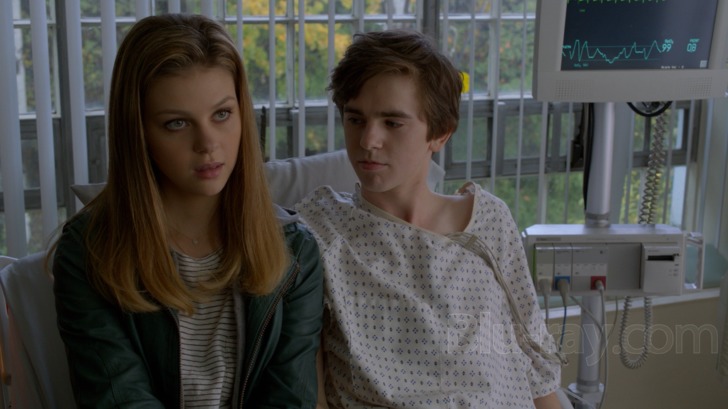
Two cinematographers are credited for five episodes each in Season One: John Bartley (Lost) and Thomas Yatsko (Fringe). Information about the shooting format was not available, but both appearance and standard modern practice indicate digital photography. The image on Universal's two 1080p, VC-1/encoded Blu-rays superbly reproduces the cinematic feel that showrunners Cuse and Ehrin say they wanted for the program, which takes full advantage of the constant rain in the Pacific Northwest to help create a contemporary film noir style. The image is so consistently sharp and detailed that the rain usually registers, even though falling rain is one of the most difficult elements to photograph. Noise and distortion are entirely absent, blacks and contrast levels are appropriately set, and the colors run the gamut from the noticeably dull and dated wardrobe favored by Norma Bates to the flashier colors of the high school girls and the bright neon of the Bates Motel sign. The greens of the surrounding forest, which turns out to be an important location, are impressively verdant.
Bates Motel: Season One Blu-ray Movie, Audio Quality 
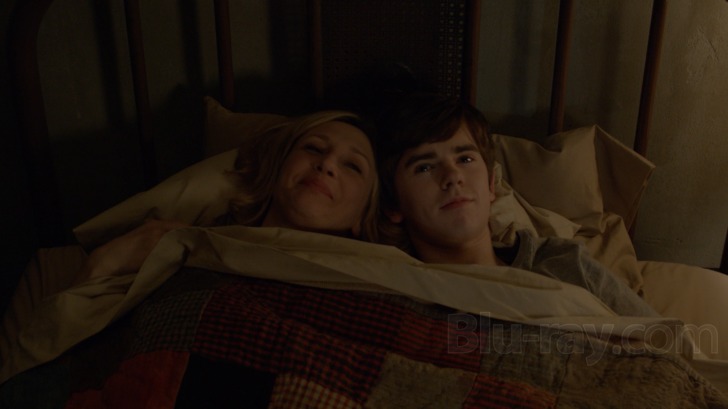
The bass extension on Bates Motel's lossless DTS-HD MA 5.1 soundtrack reaches unusually far down for a TV show, starting with the throb of the motel's neon sign switching on during the brief title sequence. That same deep impact can be felt in numerous effects, including gunshots, heavy door slams and other kinds of impacts and subjective sounds associated with troubled psychological states. A number of specific environments have distinctive sonic signatures, including, for example, a nearly derelict ship that Norman and Dylan visit at one point, the high school halls, various forest locations and a kind of "factory" where Dylan works. Dialogue is beautifully rendered, and the classic thriller-style score by Chris Bacon (Source Code) is one of the best I have heard on TV in a long time.
Bates Motel: Season One Blu-ray Movie, Special Features and Extras 
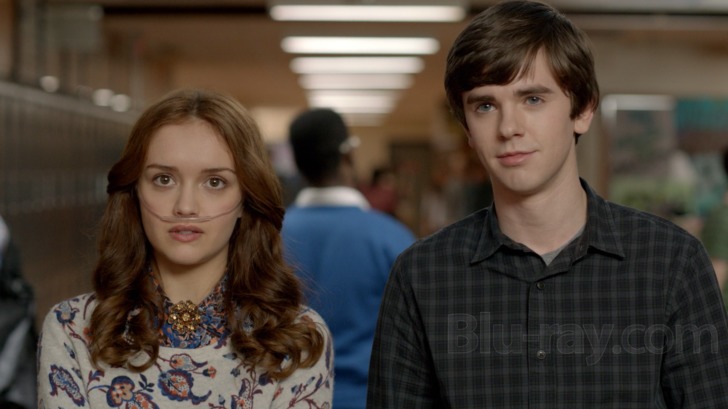
- Deleted Scenes (1080p; 1.78:1): Deleted scenes are included for most episodes. They are listed by episode but are not separately labeled. Most are short inserts, but a few suggest additional subplots or alternate directions that were abandoned or deemed unnecessary.
- Disc 1
- 1. First You Dream, Then You Die (5:21)
- 2. Nice Town You Picked, Norma . . . (2:11)
- 4. Trust Me . . . (0:24)
- 5. Ocean View (2:35)
- Disc 2
- 7. The Man in Number Nine (1:13)
- 8. A Boy and His Dog (0:57)
- 9. Underwater (3:38)
- 10. Midnight (3:33)
- Paley Center Panel Discussion with the Cast and Crew (disc 2) (480i; 1.33:1; 45:39): Nestor Carbonell, Nicola Peltz, Max Theriot, Carlton Cuse, Kerry Ehrin, Freddie Highmore and Vera Farmiga participate in a wide-ranging discussion before a live audience. The discussion covers the origin of the show, the development of the characters and possible future directions.
- Manga Cards: Inside the Blu-ray case are several postcard-size reproductions of pages from the "manga book" that Norman finds underneath the carpet in one of the motel rooms.
- Previews (disc 1) (1080p)
- House: Complete Series
- The Hollow Crown
- Covert Affairs: Season 3
- Battlestar Galactica: Blood and Chrome
- Additonal Previews: At startup, disc 1 plays trailers for Grimm, Season 1, Chicago Fire on DVD, Defiance, The Purge and The Best of Hitchcock on Blu-ray. These can be skipped with the chapter forward button and are not otherwise available once the disc loads.
Bates Motel: Season One Blu-ray Movie, Overall Score and Recommendation 

Because they appeared at roughly the same time, Bates Motel is often compared to Hannibal, the NBC mid-season replacement series chronicling the early career of serial killer and cannibal Dr. Hannibal Lecter, the character memorably played by Anthony Hopkins in The Silence of the Lambs, Hannibal and Red Dragon. Hannibal, too, is something of a reinvention, and my colleague Ken Brown placed it on his Top TV Titles on Blu-ray of 2013, where he said that it "managed to pull off everything Bates Motel tried—and failed—to do". My evaluation is the exact opposite. Both series had top production values and great casts, but Hannibal failed to create an internally consistent world in which its far-fetched plots could be credible. Sheerly for the sake of indulging in Grand Guignol, the viewer was required to believe that a supposedly brilliant profiler failed to identify the serial killer in front of him, that the FBI was hopelessly incompetent and that a top agency officer would keep a man in the field who clearly belonged in a padded cell. Bates Motel, by contrast, relied primarily on emotional violence, with just an occasional gore effect to underscore that the danger was real. The criminality of the town requires a suspension of disbelief, but at least the series creators set the town in a remote area as an explanation. And the dangerous proclivities of the lead characters are already well-known; they just haven't fully matured. Let me sum it up this way: Hannibal has disappeared from my viewing lineup, but I'm eagerly awaiting Season 2 of Bates Motel. Highly recommended.
Other editions
Bates Motel: Other Seasons

Bates Motel: Season One
2013

Bates Motel: Season Two
2014

Bates Motel: Season Two
2014

Bates Motel: Season Three
2015

Bates Motel: Season Three
2015

Bates Motel: Season Four
2016

Bates Motel: Season Four
2016

Bates Motel: Season Five
2017

Bates Motel: Season Five
2017
Similar titles
Similar titles you might also like

Proxy
2013

American Horror Story: Asylum
2012-2013

Hannibal: Season Two
2014

Psycho II
Collector's Edition
1983

Marrowbone
The Secret of Marrowbone
2017

Psycho 4K
1960

Unsane
2018

The Stylist
2020

Schizo
1976

Identity
2003

Magic
1978

Session 9
2001

The Haunting of Hill House
Extended Director's Cut
2018

Hands of the Ripper
1971

Secret Window
2004

Daniel Isn't Real
Slipcover in Original Pressing
2019

Endless Night
1972

Psycho IV: The Beginning
1990

Maniac
2-Disc Special Edition
1980

They Look Like People
Slipcover in Original Pressing
2015